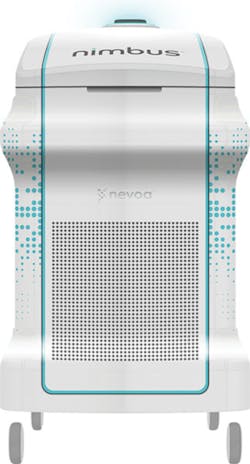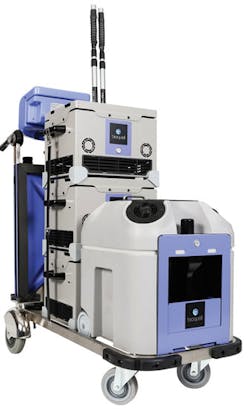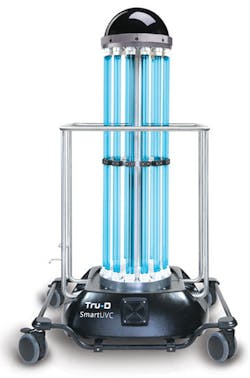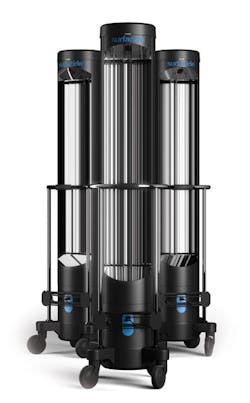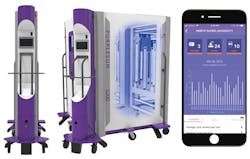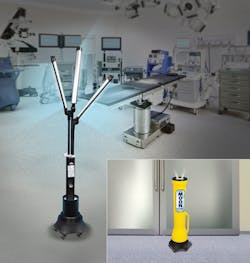Studies show that enhanced terminal room disinfection decreases the risk of healthcare-acquired infections (HAIs) by reducing the number of pathogens contaminating the healthcare environment. Quality care means measures must be taken to reduce HAIs. Quality care is good for the patient and good for the hospital. Coupling automated room disinfection with surface cleaning is a powerful one-two punch that can result in improved patient care, which can mean fewer HAIs, less expenses, fewer Medicare penalties, perhaps fewer lawsuits, and an intact reputation.
Fogging solutions
The first line of defense in environmental disinfection is cleaning the surfaces. Manual cleaning is time-consuming and labor-intensive. Nevoa has a solution that cuts down on manual labor while producing effective results. Kimberly Davey, Director of Marketing, described Nevoa’s Nimbus + Microburst solution. “We knew, to achieve an unprecedented drop in HAIs, our unique hypochlorous-acid–based hospital disinfection technology had to be fast, affordable, and the most effective. After several years of development, the result is a U.S. Environmental Protection Agency (EPA)-registered hospital-grade disinfectant safe for disinfecting patient rooms and similar facilities that require the confident assurance of complete disinfection.”
Davey continued, “To achieve registration from the EPA, Nevoa’s Microburst Solution underwent rigorous testing to demonstrate repeatedly that, when atomized by Nimbus, Microburst kills over 99.9999 percent of germs, including Salmonella enterica, Staphylococcus aureus, and Pseudomonas aeruginosa. Additional third-party efficacy studies have demonstrated complete disinfection of other common HAI sources, including methicillin-resistant S aureus (MRSA), vancomycin-resistant Enterococcus (VRE), and Clostridium difficile (C. diff). Nimbus users can be confident that every surface in the room is disinfected, including hard-to-reach areas that are most often omitted in manual cleaning or that may be completely missed by line-of-sight limitations of other technologies.”
Addressing cost-effectiveness, Davey noted, “We estimate a sizeable portion of manual terminal cleaning labor can be eliminated or re-deployed when Nimbus + Microburst is used in an every room – every time comprehensive disinfection-protocol approach.” Davey added that the labor reduction results in measurable cost savings and increased disinfection effectiveness results in cleaner rooms. “Studies have shown that cleaner patient rooms and surgical areas translate into reduced HAIs, which reduces readmission expenses and indirect expenses such as costly litigation, government fines, and insurance chargebacks.”
Maryalice StClair, Vice President, Business Development, Halosil International, Inc., described the Halo Disinfection System as a family of products that includes “HaloMist 5 percent hydrogen peroxide-based disinfectant, the HaloFogger, and task-specific room-preparation accessories, all designed to deliver infection-reducing results at a cost lower than other surface-disinfection technologies. The system delivers the efficacy of a 99.9999 percent kill of C. diff spores in a whole room, with best in-class affordability, comprehensive safety, and ease of application.”
StClair advised, when looking for a whole-room disinfection system, to “look for efficacy, affordability, safety, flexibility, and usability. “Halosil has published an e-book ‘A Buyer’s Guide to Whole Room Disinfection,’ found on our website, that provides comprehensive criteria for selecting a whole-room disinfection system.”
Financial benefits also accompany the system, noted StClair. “The Halo Disinfection System contributes toward lowering C. diff infection rates. Lowering rates saves lives and avoids costs. Hospital-onset C. diff attributable cost per case is $34,157.”1 StClair also encourages taking a look at their e-book, “Whole Room Disinfection: A Value Analysis.”
StClair referred to a success story from a user of the Halo Disinfection System, Beebe Healthcare in Lewes, DE. Tim Gwaltney, Manager, Environmental Services, explained that Beebe Health regularly uses the Halo Disinfection System in the operating and patient rooms at the main hospital and the outpatient surgery center. Beebe also is planning for a short-stay surgical center. Gwaltney said he has “been successful in convincing the architects to include the HaloPortal in the design, to allow the HaloFogger to disinfect operating rooms more easily. The HaloPortal is an accessory that facilitates permanent placement of the HaloFogger nozzle in the treated space. We are using an ATP testing system to validate the effectiveness of the whole-room disinfection.
“When we first started researching the use of whole-room disinfection, an interdisciplinary team was addressing the C. diff rates at Beebe,” said Gwaltney. “At that time, our rates were three times the national average, as reported on the Centers for Medicare and Medicaid Services (CMS) website. At this time, the C. diff rate for Beebe is at .85, below the CMS target of 1.1. There are several initiatives that have helped Beebe in achieving this milestone, and I am convinced the use of the Halo system has been a major contributor.”
Jason Merrill, Global Marketing Manager, Bioquell, believes it is important to look for “EPA approval of any disinfectant and ensure that it possesses efficacy claims against bacteria, viruses, spores, fungi, and mycobacteria.”
Merrill said Bioquell’s BQ-50 system can work to kill 99.9999 percent of organisms on all exposed surfaces, explaining, “This is typically the threshold that biopharmaceutical companies use for an aseptic environment.
“Preparing the room for decontamination includes sealing vents, removing linens, and opening cabinets and drawers. The Bioquell BQ-50 and aeration units are placed in the room, all persons exit the room, and seal the door, “ Merrill continued. “After entering in laser-calculated dimensions, pressing the green button starts the process. The Bioquell BQ-50 emits vapor onto every exposed surface, including in any adjacent bathrooms, sluices, store rooms, etc. The enclosed area then is at a standstill, allowing the peroxide to dwell on every exposed surface, ensuring high efficacy against particularly tough organisms, such as C. diff spores. Aeration units kick on automatically to convert the hydrogen-peroxide vapor rapidly into water vapor and oxygen, leaving no residue, with no further cleanup required. The room is then safe for immediate patient reoccupation.”
Merrill pointed to two studies verifying efficacy of hydrogen-peroxide vapor. A prospective before-and-after study by Boyce et al found, “HPV [hydrogen-peroxide vapor] decontamination was efficacious in eradicating C. difficile from contaminated surfaces.”2 A study by McCord et al found the C. diff infection rate resulted in a reduction from 1.0 to 0.4 cases per 1,000 patient-days in the 24 months before use of HPV compared with the first 24 months of HPV use. The study concluded, “HPV should be considered to augment the terminal disinfection of rooms vacated by patients with CDI [C. diff infection].”3
Ultraviolet-light solutions
Studies show that ultraviolet-C (UVC) light unquestionably reduces bioburden in patient rooms. Alice Brewer, Director of Clinical Affairs for Tru-D SmartUVC, described how their product works to achieve disinfection. “Tru-D SmartUVC is a portable UVC disinfection system that delivers one automated, measured dose of UVC light to disinfect an entire room consistently during one cycle.”
Brewer connected the dots between use of UVC room disinfection to the all-important issue of antibiotic resistance. “With overuse of antibiotics prevalent in healthcare, germs have grown resistant. Good bacteria also can be killed by antibiotics, leaving patients at higher risk of acquiring infection. Superbugs are not immune to Tru-D’s UVC energy.” She explained that a lethal dose of UVC destroys the superbugs’ DNA, rendering it unable to replicate.
“Only Tru-D has been proven to reduce both risk of acquisition of infection as well as incidence of multidrug-resistant organisms throughout an entire hospital,” added Brewer. “By taking the environment out of the equation, Tru-D improves patient outcomes and maximizes reimbursements, a win-win for hospitals.”
Brewer recounted an experience of successful use of Tru-D. “Oneida Healthcare in New York implemented Tru-D in 2017 and focused on utilizing UVC as an adjunct to its cleaning process. The facility reduced its C. diff rate from 0.61 to 0.18 after implementation, not only minimizing their infection rates but seamlessly integrating the robots into its workflow, thanks to Tru-D’s single placement.”4
Brewer stressed the importance of scientific evidence. “Hospital outcomes are important, but Tru-D believes in providing science that proves without a doubt that our technology is the highest standard possible. The BETR-Disinfection study, the only Centers for Disease Control and Prevention-funded randomized clinical trial on UVC, solely utilized the Tru-D device. Over two years, and within the nine hospitals in the Duke Infection Control Outreach Network, Tru-D was shown to reduce both the relative risk and incidence of HAIs. More information is available at tru-d.com/betrdstudy.”5
Xenon is a heavy, colorless, and relatively inert gaseous element employed by Xenex to create UV light, which kills pathogens in the environment. Sarah Simmons, PhD, CIC, FAPIC, Science Director, Xenex Disinfection Services, said, “UV disinfection technologies can be an effective tool in the battle against germs. Pulsed xenon UV devices have demonstrated the ability to kill the three most common drug-resistant microorganisms quickly: MRSA, VRE, and multidrug-resistant Gram-negatives.”
Simmons said HAIs are expensive to treat, with surgical-site infections (SSI) being the most expensive. “To date, the only SSI-reduction data credited to UV disinfection and published in a peer-reviewed journal is from hospitals using Xenex’s LightStrike pulsed xenon UV technology. As hospitals look for ways to improve their hospital-acquired–condition scores and take advantage of value-based purchasing, one of the most obvious areas for improvement is bringing down their infection rates. LightStrike robots are proven to be an effective tool, with hospitals experiencing fewer infections after they began using the technology to disinfect rooms and areas within their facilities.”
Simmons acknowledged it can be a challenge to choose room-decontamination products, “especially given the barrage of marketing hype and misinformation that exists.” She advised, “It’s imperative to review the clinical evidence. Ask the vendor to show you peer-reviewed studies from hospitals that saw a reduction in infection rates after they began using the technology. If they don›t have peer-reviewed and published infection-rate–reduction studies, then the technology is inadequate and has not met the standard for evidence-based medicine.
“There are now twenty-seven peer-reviewed and published studies from healthcare facilities about the efficacy of the Xenex LightStrike device, including nine from facilities that experienced infection-rate reductions after they began using a LightStrike robot,” added Simmons.
Simmons added, “The majority of peer-reviewed research on infection-rate reductions achieved with no-touch technology has resulted from hospitals using pulsed xenon UV. This research shows reductions in C. diff, MRSA, VRE, multidrug-resistant Gram-negatives, and SSI rates.” She referred to two experiences of users who saw reductions in C. diff infections. “The first describes a fifty-three percent reduction in C. diff rates at a community hospital in Massachusetts.6 The second demonstrates that increased utilization of the disinfection system resulted in enhanced infection reductions, with a seventy percent reduction in C. diff in the hospital’s adult intensive-care unit.”7
Adam Buchaklian, PhD, Director of Clinical Research, Surfacide, LLC, explained how their triple-emitter product differs from a single-emitter room-disinfection product. “Surfacide has developed the next-generation triple-emitter UV-C disinfection system, which overcomes the limitations of single-emitter systems. UV disinfection is a direct line-of-sight modality, and triple emitters substantially minimize shadows and reduce the distances to surfaces while eliminating the need for staff to move a single-emitter system from position to position. These factors provide an easy-to-use, fully automated system that integrates easily into standard workflow, with much shorter total disinfection times than those achieved by single-emitter UV or hydrogen-peroxide vapor.”
Buchaklian touched on financial advantages of their system. “The Surfacide Helios UV-C disinfection system delivers validated whole-room disinfection in a single cycle, ensuring greater total energy delivery in less time, with less labor,” continued Buchaklian. “Single-emitter UV systems require multiple positions, whereas Surfacide’s whole-room, single disinfection cycle leads to shorter times, providing the opportunity to disinfect more rooms.” Buchaklian said that some facilities currently using Surfacide “have documented first-year savings in excess of $1 million in direct cost avoidance, not including additional indirect savings and reimbursement benefits.”
Buchaklian cited results from two published studies in support of Surfacide’s UV disinfection system. The first study, from Ohio State University, demonstrated the ability of the Surfacide system to reduce both C. diff contamination from surfaces and hospital-onset C. diff when used for both daily disinfection of patient bathrooms and for terminal cleaning.8 The second study, from Jersey Shore University Medical Center, demonstrated a 53 percent reduction in catheter-associated urinary-tract infection in a surgical intensive-care unit.9
According to Luis F. Romo, Founder and CEO, PurpleSun, “PurpleSun’s FMUV [focused multivector ultraviolet] light delivery system features “a disruptive way to package, deliver, and digitally monitor the highest quality in automated medical light–based disinfection for improving quality and cost of care for hospitals.” He averred that PurpleSun’s first product can disinfect equipment in a 90-second cycle and has overcome major issues of shadowing as well as eliminating the need to evacuate the room or area during use. “These features allow PurpleSun’s FMUV Shadowless Delivery Technology to be utilized throughout a hospital to optimize workflow and enhance the disinfection capabilities between all surgery cases and patient discharges,” said Romo.
“Increasing the utilization of an infection-prevention technology will have a greater impact on outcomes over the long term,” he averred. “PurpleSun is dedicated to working with their customers to build robust protocols and sustainable integration methodologies to support them every step of the way on their journey to zero infections. PurpleSun is bringing to life the full solution for hospitals to make a fundamental shift to light-based disinfection in a similar way the industry has made a transformative shift in automated robotic surgery. This technology is worth considering and carefully comparing the differences in the PurpleSun approach. The technology is so compelling that it was commercially supported and validated by the twelfth largest healthcare system in the United States, Northwell Health.”10
Chris Batts, Director of UV-C Sales, Skytron, described his company’s reasoning behind their products. “One of our goals was to offer a broad product family of disinfection robots to meet every facility’s need and budget. A key design principal was, at each price point, to maximize the output of only the most germicidal wavelengths. That translates to highly effective disinfection treatments and maximizes customer value. Higher doses of UV-C mean higher disinfection rates. That’s why we strive for very high rates of UV-C output in our robots.
“The basic philosophy of using Skytron’s IPT disinfection process is to provide a standardized method for disinfection,” explained Batts. “It’s not just that it’s UV, it’s that it is a calibrated, standardized, and documented process that cannot be corrupted by operator error. That is the core-value proposition: it is a standardized process that removes variables such as room size, inadequate disinfection times, improperly positioned robots, or missing locations entirely. It’s not that it’s UV; UV is the means to the end. Treatment calibration, measurement, and documentation are key to quality improvements in the disinfection process. This is a critical element that is too often overlooked.”
Batts pointed to a peer-reviewed white paper, published in the American Journal of Infection Control, where robots were used to show significant results in fighting HAIs.11 The C. diff incident rate was reduced by 42.7 percent, and HAIs were reduced by more than 34 percent overall throughout the entire hospital. “The study was conducted totally independently of Skytron or its affiliates, so there is no bias or conflict of interest,” noted Batts.
Katherine Velez, PhD, Scientist, Clorox Healthcare, offered this advice for purchasers of UV room-disinfection systems: “When evaluating UV technology, healthcare facilities should determine if the manufacturer provides clinical and laboratory evidence as well as in-person training, in-servicing, and marketing support.
Optimum-UV Enlight System
Outlining attributes of their UV system, Velez said, “The Clorox Healthcare Optimum-UV Enlight System utilizes UV-C, the highest-energy form of UV light, to inactivate dangerous healthcare pathogens such as C. diff, carbapenem-resistant Enterobacteriaceae, VRE, and MRSA, in five minutes at eight feet. The Optimum-UV Enlight System offers proven efficacy, safety features, and device maneuverability, with advanced data-collection and reporting capabilities.
“Facilities should also verify the efficacy, performance, and functionality of the device by reviewing results of third-party laboratory testing for kill claims and scientific studies on facility usage,” noted Velez. An example of proven efficacy is shown in a study performed at the Hospital of the University of Pennsylvania, the 776-bed flagship hospital of the University of Pennsylvania Health System, located in Philadelphia. “The study found that deploying the Clorox Healthcare Optimum-UV System in hematology/oncology units helped reduce C. diff infection rates by 25 percent, saving up to $1.5 million in direct medical costs, without impacting room turn-over times.12 Velez referred also to a study performed at St. Mary’s Hospital for Children, a pediatric long-term–care facility in Bayside, NY. The Optimum-UV System reduced viral infection rates among vulnerable pediatric patients by 44 percent.13
“Healthcare environments are complex, and manual cleaning and disinfection may not always be optimal due to a variety of factors,” observed Carolyn Cooke, Vice President Healthcare, North America at Diversey. “Studies have demonstrated that a patient’s risk of acquiring an antibiotic-resistant organism increases if the previous room occupant was colonized or infected with that organism, reinforcing the importance of effective environmental disinfection. To help address this risk, facilities have introduced UV-C technology in recent years, to add assurance to the manual disinfection process. By adding a layer of assurance with UV-C technology, Diversey’s MoonBeam3 can help mitigate the risk for subsequent patients.”
Cooke advised, “When assessing which device is the best fit, facilities should consider room turnover time (total cycle time), total cost of the unit and its operation (acquisition, labor, and maintenance cost), efficacy, and ease of use to ensure the best return on investment.” Other considerations are portability, whether it can it be used in multiple areas, including smaller spaces and off-site; safety; and durability. Diversey’s MoonBeam3 is a lightweight, portable device. A key feature that makes the MoonBeam3 unique is its three individually adjustable UV arms, which can be positioned to allow optimal UV-C dosing on both horizontal and vertical surfaces, increasing efficacy and speeding cycle times. Its compact size and portable design enable it to be integrated effectively into standard cleaning workflows and enables its use in smaller areas, such as restrooms, as well as making it easy transport to outpatient sites. It is also more affordable than other technologies available in the market.”
References
- Zhang S, Palazuelos-Munoz S, Balsells EM, et al. Cost of hospital management of Clostridium difficile infection in United States—a meta-analysis and modelling study. BMC Infect Dis. 2016;16(1):447. https://www.ncbi.nlm.nih.gov/pmc/articles/PMC5000548/.
- Boyce JM, Havill NL, Otter JA, et al. Impact of hydrogen peroxide vapor room decontamination on Clostridium difficile environmental contamination and transmission in a healthcare setting. Infect Control Hospital Epidemiol. 2008 Aug;29(8):723-729. doi: 10.1086/589906.
- McCord J, Prewitt M, Dyakova E, et al. Reduction in Clostridium difficile infection associated with the introduction of hydrogen peroxide vapour automated room disinfection. J Hosp Disinfect. 2016 Oct;94(2):185-187. doi: 10.1016/j.jhin.2016.05.014. Epub 2016 May 31.
- Anderson DJ, Moehring RW, Weber DJ, et al. Effectiveness of targeted enhanced terminal room disinfection on hospital-wide acquisition and infection with multidrug-resistant organisms and Clostridium difficile: a secondary analysis of a multicentre cluster randomized controlled trial with crossover design (BETR Disinfection). Lancet Infect Dis. 2018 Jun 4. pii: S1473-3099(18)30278-0. Lancet Infect Dis. 2018 Jun 4. doi: 10.1016/S1473-3099(18)30278-0. [Epub ahead of print]
- DJ, Chen LF, Weber DJ, et al. Enhanced terminal room disinfection and acquisition and infection caused by multidrug-resistant organisms and Clostridium difficile (the Benefits of Enhanced Terminal Room Disinfection study): a cluster-randomised, multicentre, crossover study. Lancet. 2017 Feb 25:389(10071):805-814. doi: 10.1016/S0140-6736(16)31588-4. Epub 2017 Jan 17
- Levin J, Riley LS, Parrish C, et al. The effect of portable pulsed xenon ultraviolet light after terminal cleaning on hospital-associated Clostridium difficile infection in a community hospital. Am J Infect Control. 2013;41(8):746-748. doi:10.1016/j.ajic.2013.02.010. Epub 2013 May 16.
- Nagaraja A, Visintainer P, Haas JP, et al. Clostridium difficile infections before and during use of ultraviolet disinfection. Am J Infect Control. 2015 Sep 1;43(9):940-945. doi:10.1016/j.ajic.2015.05.003. Epub 2015 Jul 6.
- Liscynesky C, Hines LP, Smyer J, et al. The effect of ultraviolet light on Clostridium difficile spore recovery versus bleach alone. Infect Control Hosp Epidemiol. 2017 Sep;38(9):1116-1117. doi: 10.1017/ice.2017.126. Epub 2017 Jul 3.
- Hanrahan S, Haraschak C. Continued success with UV-C light disinfection – making the case for reducing HAIs. American Association for Professionals in Infection Control and Epidemiology, Inc, Annual Conference; Minneapolis, MN; June 2018. Abstract. ADS-52
- Lagnado L. Hospitals fund potential game-changers in health tech. Wall Street Journal. March 7, 2018 8:43 a.m. ET. https://www.wsj.com/articles/hospitals-vie-to-fund-a-health-tech-breakthrough-1520430189.
- Napolitano NA, Mahapatra T, Tang W. The effectiveness of UV-C radiation for facility-wide environmental disinfection to reduce health care-acquired infections. Am J Infect Control. 2015 Dec 1;43(12):1342-6. doi: 10.1016/j.ajic.2015.07.006. Epub 2015 Aug 12.
- Pegues DA, Han J, Gilmar C, et al. Impact of ultraviolet germicidal irradiation for no-touch terminal room disinfection on Clostridium difficile infection incidence among hematology-oncology patients. Infect Control Hosp Epidemiol. 2017 Jan;38(1):39-44. doi: 10.1017/ice.2016.222. Epub 2016 Oct.
- Pavia M, Simpser E, Becker M, et al. The impact of ultraviolet-C technology on viral infection incidence in a pediatric long-term care facility.” Am J Infect Control. 2018 Jun;46(6):720-722. doi: 10.1016/j.ajic.2018.01.014. Epub 2018 Mar 14.
About the Author

Susan Cantrell
Susan Cantrell is Infection Prevention Editor for Healthcare Purchasing News.

